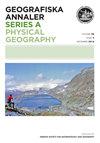英格兰西北部湖区岩质边坡破坏综述
IF 1.8
4区 地球科学
Q3 GEOGRAPHY, PHYSICAL
Geografiska Annaler Series A-Physical Geography
Pub Date : 2022-07-03
DOI:10.1080/04353676.2022.2120261
引用次数: 2
摘要
84个岩质边坡破坏(RSFs)(平均大小0.17 km2;总面积14.5平方公里)为湖区和豪吉尔丘陵,英格兰西北部。多数发育于奥陶系和志留系变质火山岩和变质沉积岩上,少数发育于奥陶系火成岩侵入岩上。rsf在性质上主要是副河流,少数是副河流。岩石边坡变形、岩石滑坡和岩石雪崩发生的比例分别为46%/36%/18%。一些RSFs或其组成部分早于LGM,一些可能是冰川期间期时代,一些可能是YDS时代,而另一些则明显是全新世时代。然而,没有数字年龄。一些RSF沉积物以前被错误地解释为侧向冰碛,或者是冰芯(冰川)或原talus/talus-foot(冰缘)岩石冰川;一些RSF空腔被误解为马戏团,尽管它们可能正在进化成马戏团。RSF的空间发生率总体上是稀疏的;一些地区缺乏证据,但两个集群占人口的56%,占无国界医生地区的58%。地质因素对破坏模式的影响大于对空间影响;地震活动不太可能是主要原因。如果石油均衡回弹在局部增加了一般的冰川均衡回弹应力,那么基岩集中侵蚀模型可以解释在冰川破碎的岩石周围聚集的RSF和扩大的槽头。湖区的RSF发病率可以看作是苏格兰高地模式的一个缩影。RSFs对该地区景观演变和地质多样性的贡献被低估了:一些案例显示出适合地理解释的重大影响。本文章由计算机程序翻译,如有差异,请以英文原文为准。
Rock slope failure in the Lake District, NW England: an overview
ABSTRACT An inventory of 84 Rock Slope Failures (RSFs) (mean size 0.17 km2; total area 14.5 km2) is presented for the Lake District and Howgill Fells, northwest England. Most are developed on Ordovician and Silurian metavolcanics and metasediments, with a minority on Ordovician igneous intrusives. The RSFs are predominantly paraglacial in nature, a few are parafluvial. Rock slope deformations, rockslides, and rock avalanches occur in the proportions 46%/36%/18%. Some RSFs, or components thereof, pre-date the LGM, some are probably of Lateglacial Interstadial age, some may date from the YDS, and others are demonstrably of Holocene age. However, numerical ages are not available. A few RSF deposits have previously been mis-interpreted as lateral moraine, and either ice-cored (glacial) or protalus/talus-foot (periglacial) rock glaciers; some RSF cavities have been mis-interpreted as cirques, although they may be evolving into them. Spatial incidence of RSF is generally sparse; several areas lack evidence, but two clusters account for 56% of the population and 58% of the RSF area. Geological factors have greater influence over mode of failure than over spatial incidence; seismicity is unlikely to have been a prime cause. A Concentrated Erosion of Bedrock model could account for RSF clustering around glacially-breached cols and enlarging trough-heads, if petro-isostatic rebound is locally augmenting generic glacio-isostatic rebound stresses. RSF incidence in the Lake District can be seen as a microcosm of the Scottish Highlands pattern. The contribution of RSFs to landscape evolution and geodiversity in the area has been underplayed: some cases display bold impacts amenable to geo-interpretation.
求助全文
通过发布文献求助,成功后即可免费获取论文全文。
去求助
来源期刊
CiteScore
3.60
自引率
0.00%
发文量
12
审稿时长
>12 weeks
期刊介绍:
Geografiska Annaler: Series A, Physical Geography publishes original research in the field of Physical Geography with special emphasis on cold regions/high latitude, high altitude processes, landforms and environmental change, past, present and future.
The journal primarily promotes dissemination of regular research by publishing research-based articles. The journal also publishes thematic issues where collections of articles around a specific themes are gathered. Such themes are determined by the Editors upon request. Finally the journal wishes to promote knowledge and understanding of topics in Physical Geography, their origin, development and current standing through invited review articles.

 求助内容:
求助内容: 应助结果提醒方式:
应助结果提醒方式:


